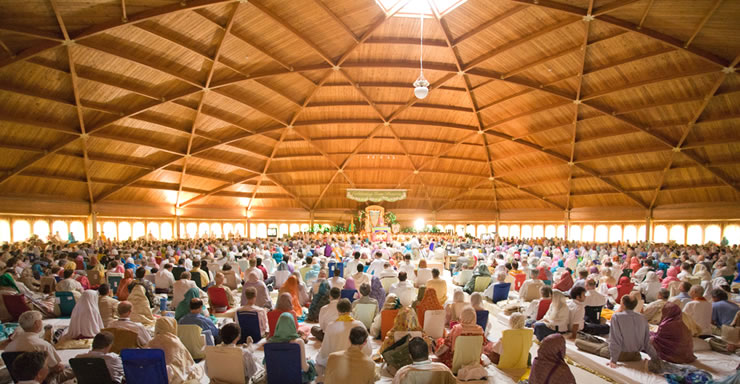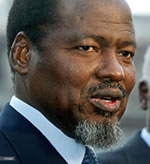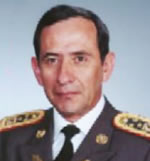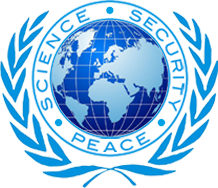Implementing the Brain-Based Approach to Peace
NATIONAL IMPLEMENTATION — Education
Assessing the societal impact of a single large group of peace-creating experts: National Demonstration Project, USA
The United States plays a pivotal role in global politics and world events. Creating a powerful influence of peace in the US—and by extension on US foreign policy—could thus have a significant positive impact on global affairs and global conflict.
Moreover, a large-scale successful implementation of the Brain-Based Approach in the US would help build support for this approach within the scientific, public policy, and philanthropic communities, and thereby accelerate the program’s acceptance, funding, and implementation on a global scale.
Previous published studies have shown that a single group of 2,500 advanced meditation experts positioned within the continental US is sufficient to produce a significant and demonstrable effect of peace and social coherence throughout the nation—defusing societal tensions, promoting social harmony, and reducing crime and violence on a national scale [21,22].
Progress Report
Phase 1: National Demonstration Project
In July 2006, the first long-term scientific demonstration project on the large-scale implementation of the Brain-Based Approach to Peace was launched in Fairfield, Iowa, USA. This experiment was designed for a University setting, and was held on the campus of Maharishi University of Management, where students, faculty and staff practice the TM and advanced TM-Sidhi program as a group, twice a day. As discussed previously, this practice fits logically and easily within an academic setting, since the benefits to brain functioning and academic performance are well documented. Because participants enjoy and benefit from their practice, compliance with the program is high. Associated costs are very low, since participants are already provided with food and housing in the context of their university education.

Peace-creating experts. Seventeen hundred and fifty advanced TM practitioners meditate together in two grand golden domes during a 2007–2010 demonstration project at Maharishi University of Management in Fairfield, Iowa, creating a powerful influence of coherence and harmony for the whole US population.
Predicted outcomes for this large-scale demonstration project were lodged in advance with the press, and included a marked turnaround of escalating crime rates across the United States. These predictions were met and exceeded. With a sustained average of more than 1,750 meditating experts (the square root of one percent of the US population) participating in this study from 2007 to 2010, the FBI Uniform Crime Index showed a dramatic and highly statistically significant decline in violent crime rates coinciding with the launch of the demonstration project, including a reduction in murder rates in major US cities to their lowest levels in over 40 years [23-25]. Simultaneous reductions were also seen in other standardized measures of societal stress, including rates of automobile and other accidental fatalities, deaths due to drugs, and infant mortality [26-28].
A 17-year study replicated and extended these findings, confirming a holistic reduction in societal stress indicators during the experimental period as well as a reversal of this effect in the five years afterward, when group size dropped below the threshold (see Scientific Research) [29]. Additional research showed a simultaneous rise in positive social trends during the experimental period, as well as broad improvements in the national economy—including a steady, highly statistically significant decline in the so-called “misery index” of inflation and unemployment [30].
Taken together, these outcomes support the theory that the Brain-Based Approach to Peace enlivens a field effect of consciousness throughout society, resulting in widespread improvements in quality of life.
Phase 2: Full Implementation
The Global Union of Scientists for Peace seeks to expand the current group of meditating experts in the US to 2,500, and thus produce a more powerful peaceful influence in US national consciousness. This will further reduce societal stress and associated social violence and, according to previous research, will help to dissolve America’s current political divisiveness and government gridlock [31]—and empower the US to become a more positive, unifying, peaceful force in global politics. Restoring and sustaining a large, national peace-creating group of 2,500 experts in the US is a primary goal of the Global Union of Scientists for Peace.
NATIONAL IMPLEMENTATION — Military
Establishing a peace-keeping wing in the military
Another successful implementation strategy for a national peace-creating group is within a nation’s security forces. These dedicated and disciplined professionals are charged to protect the nation against external and internal threats. There is very little added cost to train and equip these security forces, or a special wing within the military, with an effective tool to defuse societal stress—before it erupts into social conflict. With the Brain-Based Approach to Peace, it is not only possible but relatively easy to defuse acute societal stress, and thereby neutralize the hostility within the adversary—i.e., thereby eliminate the enmity within the enemy—and thus prevent the outbreak of war.
Implementation in Mozambique

President
Joaquim Chissano
The power of this approach was demonstrated historically when former President Joaquim Alberto Chissano of Mozambique established a Prevention Wing within his military in 1993. After 20 years of civil war that had ravaged his country, creating massive dislocation and poverty, President Chissano introduced the TM and advanced TM-Sidhi program first to his fellow leaders and commanders, and then throughout his national forces, integrating daily group practice into their military routine.
Almost immediately, the intense atmosphere of enmity that had long gripped the country subsided. Crime rates fell significantly, accompanied by strongly positive social and economic trends that culminated in free and open democratic elections—and a lasting state of peace.
President Chissano is heralded today as a preeminent peacemaker, credited with transforming the war-torn country of Mozambique into one of the most successful African democracies [32].
President Chissano and his former Commander of the Army, Lt. General Tobias Dai, presented these and related results at a series of public conferences and defense-related summits in 1994–1995. It is inspiring and instructive to quote from those conference proceedings [33]:
In our genuine search for possible solutions to the severe problems facing the country, individuals at high levels in our country’s hierarchy began the practice of the Transcendental Meditation program. After serious and critical study of this and related technologies that were being offered, the Joint Chiefs of Staff of the Armed Forces decided to implement these programs within the Armed Forces.
Thus began the sizable task of teaching these programs in the different branches of the military, including Ground, Naval, and Air Forces. During the year 1993, about 15,000 people were instructed. Immediately we saw an improvement in many problems that were prevalent among our forces: including reduced stress-related health and behavioral problems, hypertension, and insomnia. We saw reduced use of medicines, reduced hospital visits, and improved relationships and morale among the troops, who carried out their orders more efficiently. The general tension in the atmosphere was greatly reduced.
Once thousands of people were taught in Maputo, we observed a 20% decrease in violent crime—which was anomalous because, at the end of the war, an increase in crime had been expected. The same thing happened in Quelimane (a decrease of 20%) and also in the province of Manica. The population as a whole became more optimistic, and we saw renewed agricultural and economic activity throughout the country. During that year (1993), we witnessed a very unexpected 19% growth in the economy.
We were most amazed to see that peace was being maintained after so much time of conflict in the country. There was harmony among those who had previously fought. What appeared almost impossible was now a reality: brothers who had been divided by outside forces and had fought against each other, once again understood each other.
These surprising benefits culminated with the realization of free and democratic elections throughout the country, with no significant incidents of violence. Our conclusion is that the implementation of the Transcendental Meditation and TM-Sidhi program [Brain-Based Approach to Peace] within the Armed Forces of Mozambique was well worth the effort, and that results were in line with what was predicted.
—Lt. General Tobias Dai
Implementation in Ecuador

Lt. Gen. J.M. Villamil
This approach was similarly applied in Ecuador in a field test organized by then Vice-Minister of Defense Lt. Gen. José Martí Villamil de la Cadena. In 1995, Gen. Villamil launched “The Coherence Project,” in which 3,000 Ecuadorian soldiers learned the Brain-Based Approach to Peace and practiced it together—and thereby brought an end to the long-standing, escalating border conflict between Ecuador and Peru.
Gen. Villamil describes this experience in his article “Project Coherence,” published by the defense think tank India Defence Consultants [34]:
The longest and most intense border conflict in South America has persisted since colonial times between Ecuador and Peru…. In December, 1994, a face-off along a disputed border in the high jungle escalated into a major confrontation, and subsequent skirmishes created the risk of a generalized conflict.
We managed to gather six hundred civil volunteers in Quito, the capital city of Ecuador, and three thousand reserve soldiers in a nearby city. The main responsibility of these “Coherence Project” volunteers was to practice meditation [the evidence-based, stress-reducing Transcendental Meditation technique] collectively, to promote calm and social coherence in Ecuador’s disturbed, chaotic, pre-warlike state….
These three thousand soldiers—officers, cadets and troops—meditating together created a formidable wave of positive energy that could be felt at a great distance, generating an upsurge of patriotism in Ecuador and a powerful new spirit of unity. The President made effective decisions and was able to galvanize the national will. The middle ranks demonstrated their capabilities in combat, while small units and individual soldiers fought with discipline and courage. It was the first time in modern history that Ecuador did not suffer a retreat. I am convinced that the Coherence Project’s collective meditation was the key factor that brought about this change.
—Gen. Villamil
Following this implementation of the Brain-Based Approach to Peace, commerce and diplomacy between Ecuador and Peru started to improve, and these trends continue today. Cultural ties have been strengthened and tourism has increased. The two armed forces are currently planning combined maneuvers to confront common threats.
Gen. Villamil is now working with fellow GUSP leaders, generals and defense experts to establish a new, larger, more powerful peace-creating group in Ecuador to boost economic and social progress and help lead Ecuador out of “underdevelopment” by 2025.
***
Today, every nation should protect itself by establishing its own peace-creating group—whether in a university, within the military, or within a large-scale business or corporation. The benefits of reduced stress—including reduced stress-related disease, reduced crime and social violence, and increased national harmony, creativity and economic prosperity—vastly outweigh the trivial cost of training and maintaining such a group. The number of peace-creating experts required to generate a significant, demonstrable benefit is roughly (according to both theory and experiment) the square root of one percent of the national population—as few as several hundred for a small country, and up to a few thousand for the very largest countries.
The Global Union of Scientists for Peace stands ready to provide the necessary training for any country that is prepared to implement this innovative, highly effective, proven approach to peace.

